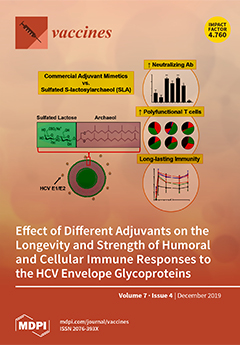Open AccessArticle
Therapeutic Vaccine in Chronically HIV-1-Infected Patients: A Randomized, Double-Blind, Placebo-Controlled Phase IIa Trial with HTI-TriMix
by
Wesley de Jong, Lorna Leal, Jozefien Buyze, Pieter Pannus, Alberto Guardo, Maria Salgado, Beatriz Mothe, Jose Molto, Sara Moron-Lopez, Cristina Gálvez, Eric Florence, Guido Vanham, Eric van Gorp, Christian Brander, Sabine Allard, Kris Thielemans, Javier Martinez-Picado, Montserrat Plana, Felipe García and Rob A. Gruters
Cited by 26 | Viewed by 5343
Abstract
Therapeutic vaccinations aim to re-educate human immunodeficiency virus (HIV)-1-specific immune responses to achieve durable control of HIV-1 replication in virally suppressed infected individuals after antiretroviral therapy (ART) is interrupted. In a double blinded, placebo-controlled phase IIa multicenter study, we investigated the safety and
[...] Read more.
Therapeutic vaccinations aim to re-educate human immunodeficiency virus (HIV)-1-specific immune responses to achieve durable control of HIV-1 replication in virally suppressed infected individuals after antiretroviral therapy (ART) is interrupted. In a double blinded, placebo-controlled phase IIa multicenter study, we investigated the safety and immunogenicity of intranodal administration of the HIVACAT T cell Immunogen (HTI)-TriMix vaccine. It consists of naked mRNA based on cytotoxic T lymphocyte (CTL) targets of subdominant and conserved HIV-1 regions (HTI), in combination with mRNAs encoding constitutively active TLR4, the ligand for CD40 and CD70 as adjuvants (TriMix). We recruited HIV-1-infected individuals under stable ART. Study-arms HTI-TriMix, TriMix or Water for Injection were assigned in an 8:3:3 ratio. Participants received three vaccinations at weeks 0, 2, and 4 in an inguinal lymph node. Two weeks after the last vaccination, immunogenicity was evaluated using ELISpot assay. ART was interrupted at week 6 to study the effect of the vaccine on viral rebound. The vaccine was considered safe and well tolerated. Eighteen percent (
n = 37) of the AEs were considered definitely related to the study product (grade 1 or 2). Three SAEs occurred: two were unrelated to the study product, and one was possibly related to ART interruption (ATI). ELISpot assays to detect T cell responses using peptides covering the HTI sequence showed no significant differences in immunogenicity between groups. There were no significant differences in viral load rebound dynamics after ATI between groups. The vaccine was safe and well tolerated. We were not able to demonstrate immunogenic effects of the vaccine.
Full article
►▼
Show Figures






